Prospector Powder Hulk at Towler’s Bay
.jpg?timestamp=1367701993828) The Royal Australian Navy was not formed until 1911. Prior to then it was the Royal Navy (Britain) that found and then established Europeans in Australia. Vessels of the Royal Navy made frequent trips to the new colonies. In 1859, the Australia Squadron was formed as a separate squadron and remained in Australia until 1913. In 1865 the Colonial Naval Brigade or New South Wales Naval Artillery Volunteers was formed. Each of the six Australian colonies operated their own colonial naval force prior to Federation; these amalgamated in 1901 as the Commonwealth Naval Forces. The Royal Australian Navy (RAN) was established in 1911, and in 1913 the fleet steamed through Sydney Heads for the first time.
The Royal Australian Navy was not formed until 1911. Prior to then it was the Royal Navy (Britain) that found and then established Europeans in Australia. Vessels of the Royal Navy made frequent trips to the new colonies. In 1859, the Australia Squadron was formed as a separate squadron and remained in Australia until 1913. In 1865 the Colonial Naval Brigade or New South Wales Naval Artillery Volunteers was formed. Each of the six Australian colonies operated their own colonial naval force prior to Federation; these amalgamated in 1901 as the Commonwealth Naval Forces. The Royal Australian Navy (RAN) was established in 1911, and in 1913 the fleet steamed through Sydney Heads for the first time.
The major ports in the colony of New South Wales were Newcastle, Wollongong and Sydney. Other minor ports, such as Pittwater, were located on the north and the south coasts of the colony but were not defended by fixed fortifications or naval vessels although these did visit. Our Sydney area was divided into two districts for defence purposes, Port Jackson and Botany. The major functions of the naval forces in these two districts were the manning of some of the ordnance mounted at the forts, operation of the Examination Service and manning of the second class and auxiliary vessels. As the colony developed The Marine Board, Ordnance Stores and associated Maritime Industries were formed. These all worked together when required. Naval personnel who were unallocated were used as part of the colony’s reserve. When fully mobilised the naval forces of the colony were under the command of the General Officer Commanding the NSW Military Forces.
The local Vessels for Defence Purposes (NSW) of this era were: Thetis 327 tons, 10 knots, 168 tons coal, 7 days endurance; Ajax 373 tons, 11 knots, 228 tons coal, 9 1/2 days endurance; Hector 99 tons, 8 knots, 72 tons coal, 3 days endurance; Little Nell 84 tons, 93/4 knots, 18 tons coal, 18 hours endurance; Charybdis 109 tons, 8 knots, 102 tons coal, 4 days endurance; Ceres 154 tons, 10 knots, 96 tons coal, 4 days endurance; Juno 487 tons, 9 knots, 90 tons coal, 3 days endurance; Nemesis 15 tons, 11 knots, 12 tons coal; Orestes 194 tons, 11 knots, 96 tons coal, 4 days endurance; Gladys 9 tons, 11 knots; Carrington 10 tons, 9 knots; Mabel 7 tons, 8 knots; Premier 15 tons, 8 knots; Kate 15 tons, 11 knots; Ena 18 tons, 91/2 knots; Sol 7 tons, 8 knots; Ganymede 9 knots, 10 tons coal, 2 days endurance. (1)
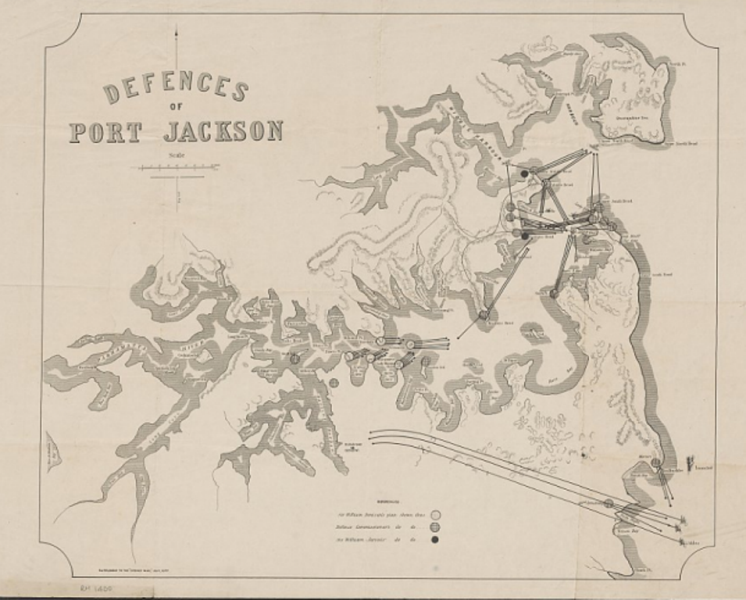
Defences of Port Jackson [cartographic material] : supplement to the "Sydney Mail", July, 1877. MAP RM 1400. courtesy National Library of Australia.
In 1826 the first proposals for establishing a Gunpowder Magazine at Goat Island were discussed. Prior to this gunpowder was stored at Fort Philip (current site of the Sydney Observatory) and in an Ordnance Store (also known as the Commissariat Stores) at the west side of Circular Quay. A floating magazine was also employed at this time. On 31 December 1832 the Sydney Gazette stated:
"His Excellency the Governor, in company with the Master Attendant, and several other gentlemen, proceeded on Friday last to Goat Island, for the purpose of fixing on a proper spot to erect a powder magazine, the floating one being too small to contain one half the powder now in this Colony."
Powder Magazines were also known as Powder Hulks. A hulk is a ship that is afloat, but incapable of going to sea. The term most often refers to an old ship that has had its rigging or internal equipment removed, retaining only its float ability. A powder hulk was a hulk used to store gunpowder. These hulks were floating warehouses which could be moved as needed to simplify the transfer of gunpowder to warships. Their location, away from land, also reduced the possible damage or danger to people from an explosion.
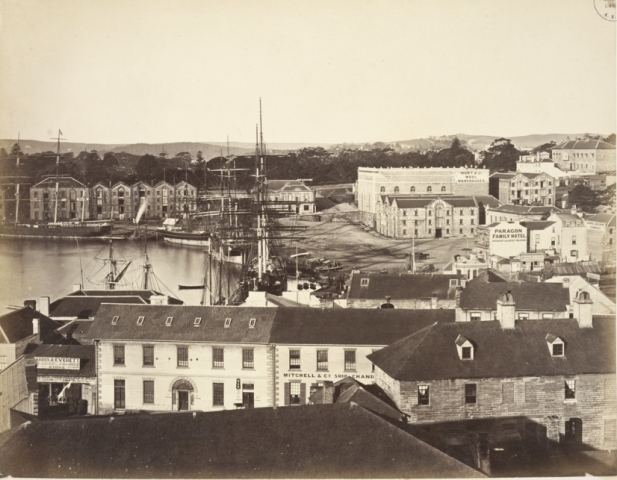 Left: Circular Quay, circa 1875. Image No.: a2229010h, Courtesy State Library of NSW
Left: Circular Quay, circa 1875. Image No.: a2229010h, Courtesy State Library of NSW
In August 1836 an Act to ensure the Government's Officers of Ordnance oversaw private or merchants stocks of gunpowder was tabled. By January 1838 this notice appeared:
The whole of the powder has been landed into the magazine at Goat Island, from the powder hulk lately moored off the North Shore. This vessel will, we believe, be fitted up to receive the diving apparatus, shortly expected from England for the Engineer Department. Ship News. (1838, January 13). The Sydney Gazette and New South Wales Advertiser (NSW : 1803 - 1842), p. 2. Retrieved from http://nla.gov.au/nla.news-article2549492
A new Act to oversee the storage of all gunpowder ensured a safer environment in a pre-Crimean war nervous colony of Sydney;
No. XLVII. An Act for the Establishment of the Colonial Gunpowder Magazine lately erected on Goat Island. [28th December, 1852.]
WHEREAS the Gunpowder belonging to private individuals at Sydney has hitherto been stored in a Magazine belonging to Her Majesty's Imperial Government and under the charge of the Ordnance Storekeeper at Sydney by the consent of Her Majesty's Imperial Government and under the authority and subject to the provisions contained in an Act of the Governor and Legislative Council of New South Wales passed in the seventh year of the reign of the late King William the Fourth intituled " An Act for better regulating the keeping and carriage of Gunpowder" and subject to the provisions contained in a certain other Act of the said Governor and Council passed in the fifth year of the reign of Her present Majesty intituled " An Act to amend an Act intituled ' An Act for better regulating the keeping and carriage of Gunpowder' " And whereas Her Majesty's Government has required that such Gunpowder should be no longer kept in the said Gunpowder Magazine but has consented that a Magazine for the storage of Gunpowder belonging to the Colonial Government and to private individuals in the said Colony should be erected by the Colonial Government on the Island belonging to the Board of Ordnance known as Goat Island in the Harbour of Port Jackson to be under the control of the Governor for the time being of the said Colony but to be in charge of Her Majesty's Ordnance Storekeeper for the time being at Sydney And whereas a Colonial Gunpowder Magazine has been erected accordingly on the said Island at the expense of the Colonial Government And whereas it is expedient that such new Magazine should be established by law as the Magazine for storing Colonial Gunpowder and that proper officers should be appointed for that purpose and that all payments for the storage of Gunpowder therein should be required to be made to the said Colonial Government Be it therefore enacted by His Excellency the Governor of New South Wales with the advice and consent of the Legislative Council thereof as follows :—
1. Such new Powder Magazine shall be under the control of the Governor for the time being of the Colony but in charge of Her Majesty's Ordnance Storekeeper at Sydney and proper and efficient officers and servants shall and may be provided and appointed by the
said Governor for the care and management of the said Magazine and the Powder therein under the general superintendence and charge of such Ordnance Storekeeper and the said Ordnance Storekeeper shall possess and exercise in respect of and in relation to such Colonial Magazine and of and to the storage of Gunpowder therein the same powers as were conferred upon him by the said recited Acts or cither of them.
2. All Gunpowder belonging to private individuals now stored in Her Majesty's Magazine at Goat Island shall be removed to and deposited in the said Colonial Magazine to be therein kept at and subject to the rents by the first of the said recited Acts imposed or such other rents as may from time to time be fixed and imposed but previous to such removal the packages and barrels containing such Gunpowder shall be examined and wherever such packages are found to be insecure the Gunpowder therein shall be removed at the expense of the owner thereof into secure and proper packages as provided by the said first recited Act in respect of Powder on its original removal from the ship or vessel in which the same may have been imported. Retrieved from; http://www.legislation.nsw.gov.au/sessionalview/sessional/act/1852-47a.pdf
An explosion of nitro-glycerine in Bridge street, Sydney in 1866, caused Henry Parkes to state a safer solution to such events must be found. The beginnings of storing powder or any explosives further from populated areas, already discussed, became more so. The full report presented later in March 1886 can be read here: EXPLOSION IN BRIDGE-STREET. (1866, March 23). Empire(Sydney, NSW : 1850 - 1875), p. 2. Retrieved from http://nla.gov.au/nla.news-article60594202
An old photograph found and published in 1932 gives a clearer picture:
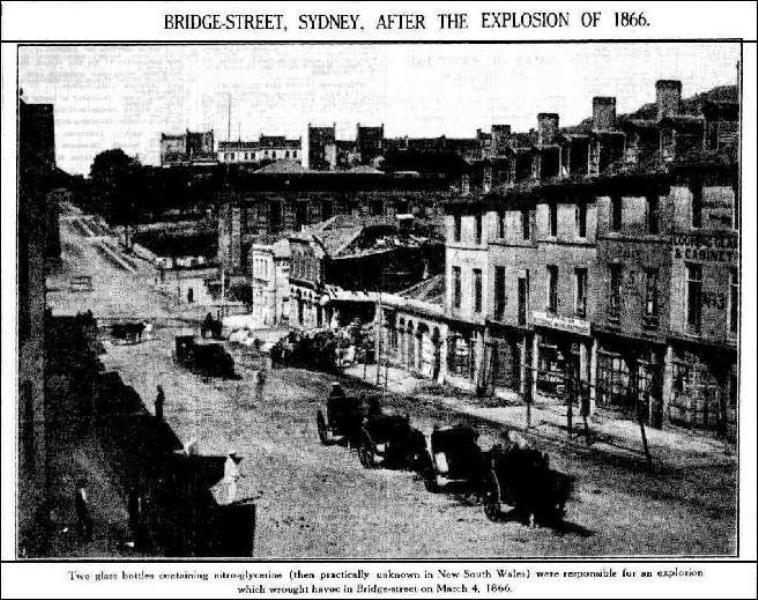 BRIDGE-STREET IN '66. A Terrific Explosion.
BRIDGE-STREET IN '66. A Terrific Explosion.
(BY J. ARNOLD CROCKETT.)
Bridge-street, city, presented a shell-shattered appearance soon after 6.30 p.m. on March4, 1866. Fortunately it was a Sunday evening, otherwise the terrific nitro-glycerine explosion which totally destroyed No. 17, the premises of Mollson and Black, ship brokers, would have resulted in fatal consequences. As it was, every pane of glass between Pitt and George streets was smashed; even the windows at the Mint (Macquarie-street) were shattered, while portion of a chair was hurled as far as Church Hill. Telegraph posts were torn down; dust and smoke ascended to a height of 150ft; the roadway was strewn with lead gutterings and large beams. A strong wind carried some of the firm's papers to St. Philip's Church. The explosion was heard at Miller's Point by a man who described it as resembling "a salvo from a man-o'-war." Opposite the scene of the disaster was a fruiterer's shop; the window was stove in, and the frightened proprietor took a fit. Few were aware of the dangerous properties of nitro-glycerine. The explosive was practically unknown in Australia. As the Melbourne "Argus" said: Probably not one in 20, even among educated people in the colonies, had ever heard of nitro-glycerine until the recent explosion Informed them that a liquid of that name Is an article of commerce, and that It possesses ten times the explosive power of gunpowder.
Thousands thronged the street. Intense interest was taken In the disaster. The "Herald" devoted a whole column to the incident-and they were columns in those days-small type few paragraphs, no centre titles, and none of the modern lay-out as we know it to-day.
An official inquiry was held. In a letter to the commissioners Henry Parkes (afterwards Sir Henry) said:
The character of the late catastrophe is so novel, and presents so many possibilities, and even probable dangers to life and property, that the Government hopes that the eminent scientific acquirements Included in the composition of your board will be employed to discover the true nature of the fatal agencies that are supposed to have caused it, and the best means of effectively affording security to society against the occurrence of similar calamities.
Alas for the "scientific acquirements" of the board's personnel, which included the genial Inspector-General of Police (Captain J.McLerie) Far from being "eminent" it knew very little about nitro-glycerine, in fact, it was difficult to find anyone in Sydney who knew anything at all about this "new" explosive.
AN INTERESTING PHOTOGRAPH.
Of unusual interest is the splendid photograph that appears on this page. It is an exclusive print, and shows the site of the present business quarters of Burns, Philp, and Co., Ltd., of Tylors (Australia), Ltd., Smith and Lane, and Gibbs Bright and Co. Scottish House occupies portion of the site where the disaster took place, while the Exchange Hotel, though reconstructed, still remains where it did in 1866. BRIDGE-STREET IN '66. (1932, July 16). The Sydney Morning Herald (NSW : 1842 - 1954), p. 9. Retrieved from http://nla.gov.au/nla.news-article16903565
By December 1882 the floating magazines Pride of England and Behring together with the guardship Alacrity, had been established in what is now called Powder Hulk Bay, Seaforth, Middle Harbour. from A Night on the Powderhulks. George Champion OAM and Shelagh Champion OAM. May 2003.
The influx of prospectors looking for gold from 1860, an occupation which employed dynamite, as much as a prevalent and well founded threat from nations Britain was at war with sending vessels to the Pacific to annexe colonies, increased the need for armaments and their storage.
The Prospector was a Barque, 235 tons, her length was 123 ft and like many barques of this period which were commonly used as freighters, she had three masts. Built Scotland at Peterhead, 1863; reg. Newcastle, 5/1878, she was hit by a mud punt while moored at Newcastle wharf on May 2nd, 1884, near AA Company’s wharf, and her days of carrying everything and everyone to and fro from places as varied as the United States, Hong Kong and regular trips between Fiji and Otago, New Zealand, were over. At the time of her sinking she was carrying coal to Sydney from Newcastle. This photo below, although a barque 25 feet shorter then the Prospector, gives some indication of a cruder version of a Powder Hulk;
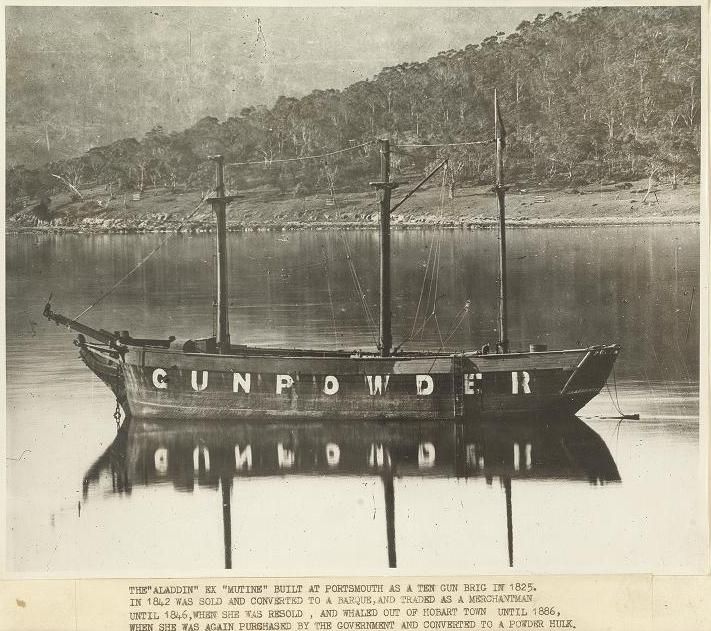
'Barque "Aladdin" - Launched as the Gun Brig "Mutine", H.M. Royal Navy, 1816. Sold out of the Service in 1842 and purchased by Mr. Charles Seal of Hobart Town in 1846. Remained in commission as a whaler until 1885 when she was purchased by the Tasmanian Government for use as a powder hulk. She was broken up at Hobart in 1902. Dimensions - Length - 98ft. Breadth - 23.4ft. Depth - 18.6ft.' Image 602986, courtesy State Library of Tasmania.
SINKING OF THE BARQUE PROSPECTOR. By TELEGRAPH., NEWCASTLE, FRIDAY.
This morning, about 7 o'clock, the Government steamer Ajax was coming down the blind channel of the harbour with a loaded mud punt in tow. As they neared the barque Prospector, lying at No. 2 staith, the punt did not answer the helm and ran into the barque, striking her about the fore rigging and sinking her in less than five minutes. She was nearly full of small coal for Sydney. She belongs to Mr. Mitchell, M.L.A., of Sydney; the water is now six feet up her foremast, and the tide is rising. The Marine Board inquiry is not yet commenced.
LATER.
The ketch Ada and the barque Prospector remain in the same positions at high tide this afternoon. The Prospector’s deckhouse was submerged nearly two foot. If the disaster had occurred 20 minutes earlier this morning the gang of coal-trimmers working below at that time must have been drowned, as she went down so suddenly. SINKING OF THE BARQUE PROSPECTOR. (1884, May 3). The Sydney Morning Herald (NSW : 1842 - 1954), p. 12. Retrieved from http://nla.gov.au/nla.news-article13570825
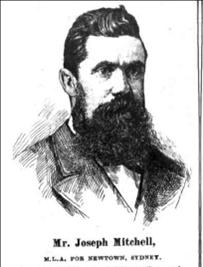 A NEW MEMBER FOR NEWTOWN. MR. JOSEPH MITCHELL, M.L.A.
A NEW MEMBER FOR NEWTOWN. MR. JOSEPH MITCHELL, M.L.A.
(See portrait on page 498.) A week or two ago we gave a portrait and biography of Mr. Joseph Abbott, who had been elected one of the three members for Newtown in the Legislative Assembly of New South Wales. This week we publish the portrait of Mr. Joseph Mitchell, who has just been returned for Newtown in the place of Mr. W J. Foster, resigned. Mr. Mitchell was born in Cheshire (England) in 1840, and educated in Mason's Academy, in his native place, and arrived in Sydney in 1862. He was appointed inspector in the construction branch of the railway service on the southern line, and the main line of railway from Mittagong to Marulan was constructed under his supervision. He remained in this position for four years, and then took to contracting, which business he also followed for four years. During the last seventeen years, however, he has devoted his attention to the coal trade and shipping, his output having averaged about 3000 tons per week for a great part of this time. Mr. Mitchell is of an inquiring mind, and fond of travel, and has visited Spain, Italy, Russia, Turkey, and the United States of America. Some six or seven years ago he took a trip to China and Japan, and was much interested in what he saw in those countries; his observations leading him to the conviction that any large in-flux of the people of those countries into Australia would have very serious consequences for the white races. In 1883 Mr. Mitchell defeated Mr. Henry Copeland (who had accepted a portfolio as Minister of Works) and he represented Newtown in the Assembly for nearly three years, or until the Parliament was dissolved. He has always been a consistent free trader, and is always out-spoken, able, and willing to express an intelligent opinion on all public matters. A NEW MEMBER FOR NEWTOWN. (1888, March 10).Australian Town and Country Journal (NSW : 1870 - 1907), p. 13. Retrieved from http://nla.gov.au/nla.news-article71095218
RAISING OF THE BARQUE PROSPECTOR. [BY TELEGRAPH, (FROM OUR OWN CORRESPONDENT.) NEWCASTLE, WEDNESDAY. The delay; in raising the barque Prospector was caused by a leak having been sprang through the deck beams, and the decks having sunk from 9 to l8 inches, some of the beams having been broken across. This opened the duck seams, and the water poured through. A large centri-fugal pump having been procured from. Sydney, operations were re-commenced on Tuesday night, at 11 o'clock, and at half-past 3 this morning till the water was got out. She was then left till high-water, at 10am. to-day, when she was taken in tow by the Drone and Adeline, and beached at Stockton, an anchor having been previously laid out for her there. Great credit is due to the divers, Messrs. Nicol, Beason, and Jones, for the manner in which they have executed all the works entrusted to them, including the placing of the props, and all other work under water. Owing to the flood in the river muddying the water the work had to be done in total darkness , in fact, literally speaking, at times they could hardly see their hands before their face. Mr. Hickson is about to call for tenders for the purchase of the barque as she now lies. RAISING OF THE MARQUE PROSPECTOR. (1884, July 10).The Sydney Morning Herald (NSW : 1842 - 1954), p. 10. Retrieved May 3, 2013, from http://nla.gov.au/nla.news-article13569306
THE question of the safe storage of dynamite and nitro-glycerine is still engaging the attention of the Colonial Treasurer. As he stated some days ago would be done, the barque Prospector, which became the property of the Government through a collision which caused the vessel to sink in the harbour of Newcastle, has been repaired, with the view of turning her into a dynamite hulk, and yesterday the vessel arrived in Sydney from Newcastle, and was towed to the Government dock at Cockatoo Island, where her docks will be caulked. When that has been done the explosives will be placed on board, and the vessel, with her stores, will be taken round to Broken Bay. In addition to this precaution, Mr. Dibbs intends to introduce into the legislative Assembly a bill to repeal the schedule of the present Gunpowder and Explosives Act, which fixes certain rates or charges for the lighterage end storage of explosives, and to substitute in lieu of this schedule a scale of charges to be fixed by the Governor and the Executive Council. Its object in this is to obtain the power to impose charges which will have the effect of materially reducing the importations of dynamite and other dangerous explosives. At present the charges imposed under the Act are not only too small to be any check upon the importations, but they ere not sufficient, by a very large sum, to meet the annual cost of maintaining the magazines. NEWS OF THE DAY. (1884, October 1). The Sydney Morning Herald (NSW : 1842 - 1954), p. 9. Retrieved from http://nla.gov.au/nla.news-article28370167
Ordnance and Barrack Department: Fitting up hulk "Prospector" as a Dynamite Magazine—further sum ... ... ... £630 10 2. from: No. XXVII. An Act to appropriate and apply out of the Consolidated Revenue Fund of New South Wales certain Sums to make good the Supplies granted for the Service of the Year 1880 and for the Year 1885 and previous Years. [25th October, 1886.] Retrieved from http://www.legislation.nsw.gov.au/sessionalview/sessional/act/1886-32a.pdf
Mr. GARRARD asked, without notice, when the hulk Prospector, now loading with dynamite at Goat Island, would be removed to a safe distance from the metropolis.
Mr. DIBBS said that the loading was nearly completed, and the hulk would probably be removed within 48 hours. PARLIAMENT OF NEW SOUTH WALES. (1884, November 26).The Sydney Morning Herald (NSW : 1842 - 1954), p. 6. Retrieved from http://nla.gov.au/nla.news-article13587033
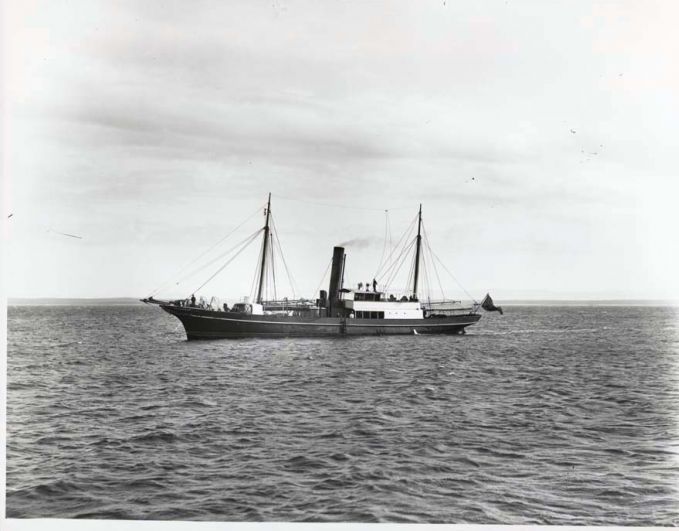 WE learn that the hulk Prospector, with 6500 packages of dynamite and nitro-glycerine, will be towed away early this morning to a safe spot that has been selected in Broken Bay, where she will be stationed, with her dangerous cargo, out of harm's way. A proclamation will be issued defining the precincts of the vessel, which will be declared a magazine under the provisions of the Gunpowder and Explosives Consolidation Act. It will be remembered that Mr. Dibbs, in the Legislative Assembly on Wednesday afternoon, said those dangerous explosives should be removed within 48 hours, and from the above it will be seen that his promise will be fulfilled. NEWS OF THE DAY. (1884, November 28). The Sydney Morning Herald (NSW : 1842 - 1954), p. 7. Retrieved from http://nla.gov.au/nla.news-article13584424
WE learn that the hulk Prospector, with 6500 packages of dynamite and nitro-glycerine, will be towed away early this morning to a safe spot that has been selected in Broken Bay, where she will be stationed, with her dangerous cargo, out of harm's way. A proclamation will be issued defining the precincts of the vessel, which will be declared a magazine under the provisions of the Gunpowder and Explosives Consolidation Act. It will be remembered that Mr. Dibbs, in the Legislative Assembly on Wednesday afternoon, said those dangerous explosives should be removed within 48 hours, and from the above it will be seen that his promise will be fulfilled. NEWS OF THE DAY. (1884, November 28). The Sydney Morning Herald (NSW : 1842 - 1954), p. 7. Retrieved from http://nla.gov.au/nla.news-article13584424
THE hulk Prospector, which has some 6500 packages of dynamite, &c on board, was towed to Broken Bay yesterday. NEWS OF THE DAY. (1884, November 29). The Sydney Morning Herald (NSW : 1842 - 1954), p. 13. Retrieved from http://nla.gov.au/nla.news-article13573752
Above Right: The Thetis, Sydney's temporary pilot steamer from 1871 until 1877, Courtesy State Records New South Wales [4481_a026_000478]
BROKEN BAY-.Arrival November 28, Thetis (s.), with powder hulk in tow. (FROM BOARD AT TELEGRAPH OFFICE.). (1884, November 29). The Sydney Morning Herald (NSW : 1842 - 1954), p. 12. Retrieved from http://nla.gov.au/nla.news-article13573739Putting those in Pittwater at a similar risk of being blown to bits didn't seem to come into account for a few more years yet. A proclamation was promptly published;
A Proclamation by His Excellency the Governor appeared in a supplement to the Government’s Gazette published yesterday, declaring and appointing the vessel Prospector to be a floating magazine for, the storage of explosives. The position of the vessel is thus defined:-"The said vessel shall be moored in the waters of the port of Broken Bay; that is to say, in a bight or bay on the western Shore of Pittwater, known as Towler or Morning Bay, in about six fathoms of water, and about 375 yards from land north, south, and west of the said bay; and that the precincts thereof shall be as follows, viz., a distance of 20 yards from any part of the vessel : And I do hereby proclaim that the same shall be, on and after the date hereof, the precincts of the said floating magazine; "Any person entering such precincts without authority, and refusing to withdraw after being directed so to do by the Ordnance Storekeeper or other person under his authority, may be either forcibly removed or taken into custody for the purpose of being brought before the nearest Court of Petty Sessions, and will be liable to a penalty not exceeding £20. NEWS OF THE DAY. (1884, December 16). The Sydney Morning Herald (NSW : 1842 - 1954), p. 9. Retrieved from http://nla.gov.au/nla.news-article28365581
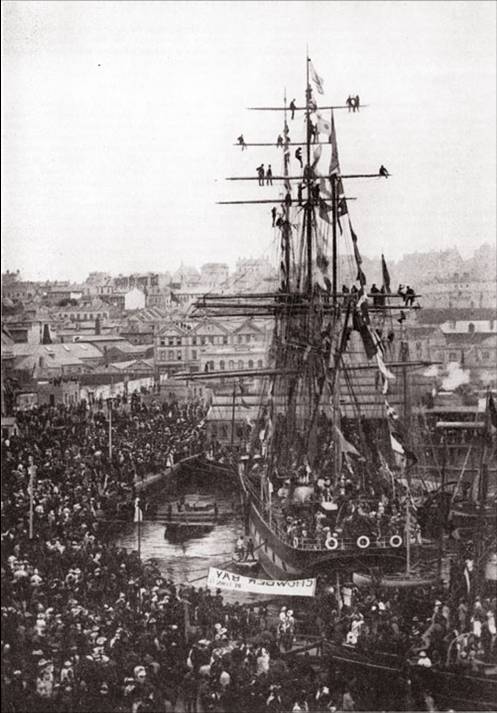 In 1885, some 200,000 people of a total Sydney population of 300,000 turned out to farewell a contingent of volunteers departing to support Britain's imperial war in the Sudan. Soon afterwards, Britain moved troops urgently to protect India's north-west frontier 'against the designs of the "Unspeakable Russian Bear"' in Afghanistan. With 'Russophobia' rampant again, rumours circulated in Sydney that a Russian fleet intent of invading the colony was on its way. Under the blunt heading 'War', the Town and Country Journal explained that '[Russia's] tactics, it is believed, includes sending a flood of privateers, backed by a squadron, to loot the colonies'.
In 1885, some 200,000 people of a total Sydney population of 300,000 turned out to farewell a contingent of volunteers departing to support Britain's imperial war in the Sudan. Soon afterwards, Britain moved troops urgently to protect India's north-west frontier 'against the designs of the "Unspeakable Russian Bear"' in Afghanistan. With 'Russophobia' rampant again, rumours circulated in Sydney that a Russian fleet intent of invading the colony was on its way. Under the blunt heading 'War', the Town and Country Journal explained that '[Russia's] tactics, it is believed, includes sending a flood of privateers, backed by a squadron, to loot the colonies'.
Dean Boyce, 'Defending colonial Sydney', Dictionary of Sydney, 2008, From HERE
Left: Circular Quay, Sydney, on March 3rd, 1885. Farewell the volunteers bound for Suakim in the Sudan, Charles Bayliss photo
By April all Sydney newspapers were filled with alarming reports and calls for action to defend the colony;
ARE WE READY? By SIR GALAHAD.
The rumored approach of a Russian fleet, having for its object the invasion of Australia, is evidence of a danger that we have never yet had to contemplate. During the century of our life as a British country, no powder has been burned in anger in Australasian seas, and the rude shock of war's alarms is as unknown to Australians as though the millennium had arrived. But we are likely to be rudely awakened from this paradisaical condition, and before we are a month older may possibly hear the unwelcome roar of Russian cannon along our coast. As a matter of course, the capitals of the various colonies will be attacked first, and Sydney being so near the coast, will probably be selected as the initial point of attack. Melbourne is well protected by the Cerberus and her torpedo boats, while Adelaide has her new gunboat, the Protector. Hobart can well defend herself by torpedos ,the approach by river affording peculiar facilities for this mode of defence. " Fremantle, it is asserted, will be guarded by the Nelson, and in this case Sydney, having the most need of naval protection, will be left .absolutely defenceless. For, although the harbor of Port Jackson is probably amply defended with its double line of batteries and Bunkon torpedos, yet on the coastal side, save at the South Head and La Perouse, not a solitary gun could be brought to bear against a Hoot. Consequently a hostile fleet could lay to at its leisure, and bombard Sydney from tho safe shelter of Bondi or Maroubra bays, holding the city to ransom, or destroying it, as suited the sovereign will of its commander. Or again, a force could be landed at Coogee under cover of the ships, and seizing the water works, 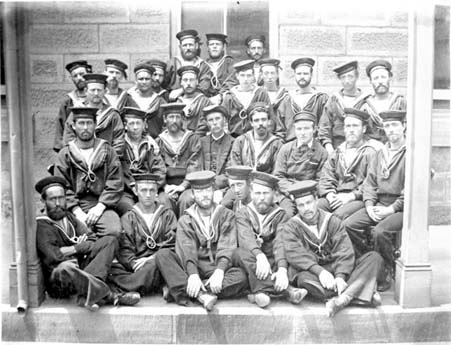 starve the city into submission. Under the circumstances, it is absolutely necessary that gunboats of a type suitable to deep-sea warfare should be obtained.
starve the city into submission. Under the circumstances, it is absolutely necessary that gunboats of a type suitable to deep-sea warfare should be obtained.
Right; Sailors of the HMS Nelson, Sydney Harbour c1885, Robert Hunt. Image No: 811060042 courtesy Macleay Museum. Below HMS Nelson on Sydney Harbour.
The Nelson alone would not be sufficient as, even if she could, hold a force at bay, there would be nothing to, prevent part of the fleet menacing Newcastle, the only other vulnerable city upon our coast: We can fairly request the British Government to grant this protection, having shown our patriotism in giving England help unasked. But to he of any value- it must be sent quickly, and therefore the news that the Australian squadron is to be strengthened is welcome indeed. The fact must be stared in the face that Sydney, to an ironclad squadron, even of no great strength, but armed with weapons of modern type, is absolutely defenceless. The old wooden hulks that were probably formidable in Nelson's time would be knocked into matchwood, without the power absolutely of striking an effective blow in return. On land our forces might do something in the way of defence, but on the briny we are literally at sea. Let us hope that England will, in her might, send us ships, otherwise a dread calamity may befall this fair city of Sydney. The ground for the camp at South Head has been picked, 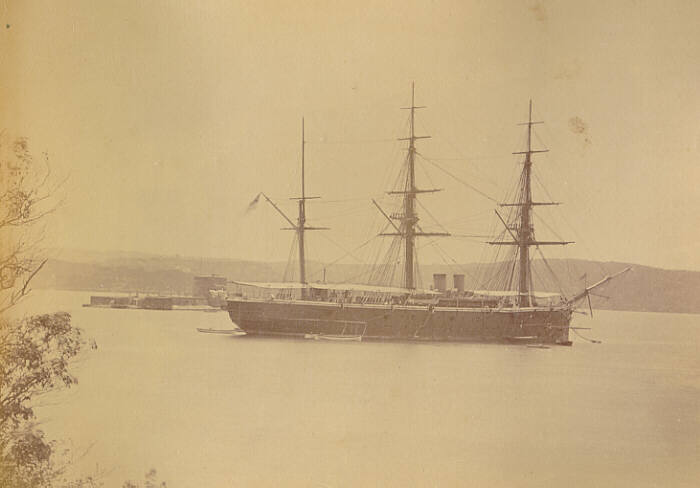 and is near the barracks there. The difference between camping in tho past and now will be that upon the arrival of the forces on their field they, will have to pitch their own tents, and will receive a good lesson in that important duty by so doing.
and is near the barracks there. The difference between camping in tho past and now will be that upon the arrival of the forces on their field they, will have to pitch their own tents, and will receive a good lesson in that important duty by so doing.
It is asserted that the Government proposes to organise a militia force of all males in the colony in the event of war breaking out between Britain and Russia. This would, of course, necessitate the calling together of Parliament again, to obtain the requisite authority. Consequent no doubt upon the alarming telegrams which have appeared, and have described the strained relations between Britain and Russia, events are happening which show that for some reason or another, the New South Wales Government shares "in the apprehensions that"' a hostile' attack might at any moment be rendered possible.. It was said that his Excellency the Governor had received a dispatch stating that war would be declared within 24 hours, but on this matter of course Ministers, when questioned, were silent. But on Monday a lengthy Cabinet Council was held which may, in fact, be called, and was by one Minister described as a " council of war," at which the question of making immediate arrangements for the defence of Sydney, Newcastle, and Botany, were under consideration.
Ministers availed themselves of the presence and advice of General Scratchley, Captain Auckland, naval adviser to the Government, Lieutenant Arnold, torpedo instructor, Lieutenant Artley, torpedo officer of H.M.S. Nelson, permitted to come to Sydney for a few days .by Commodore Tryon, Colonel Roberts, Captain Hixson, E.N., and Captain P. B." Walker, of the local torpedo corps. A course of action was determined upon, and the necessary steps for carrying out the recommendations of the naval and military authorities commenced at once. All else that can be now effected will be completed within 10, days. The channels at all ports accessible to an enemy will be protected by torpedoes, and a complete torpedo defence for Sydney, Newcastle, and Botany will be completed within a few days. The wooden hulks now at Broken Bay and Middle Harbor are under orders to be towed to a place of safety at any moment . ARE WE READY?. (1885, April 4). Australian Town and Country Journal (NSW : 1870 - 1907), p. 15. Retrieved from http://nla.gov.au/nla.news-article71025921
THE DEFENCE OF THE COLONY. The Government are in possession of no other intelligence with regard to the probability of war than that derived from Reuter, which is to the effect that the Czar had left St. Petersburg for Moscow, and that war is inevitable. No such intimation has been received by the Government either from the Agent-General or the Imperial Government. The arrangements for the defences may be said to be now completed, all guns are in position, and the necessary steps have been taken to have all available forces under arms within 2 hours of the receipt of news that war has been declared. The dynamite ship has been removed from Pittwater, and the powder hulk is now being taken from Middle Harbour. Both vessels will be placed in safe and secluded spots. THE DEFENCE OF THE COLONY. (1885, April 29). The Sydney Morning Herald (NSW : 1842 - 1954), p. 9. Retrieved from http://nla.gov.au/nla.news-article13587510
By the end of 1885 the powder hulk was taken back to Pittwater and tenders to ferry explosives to and from the Prospector were advertised from 1886;
TOWAGE of LIGHTERS to and from the PUBLIC MAGAZINES of FOWLER or 'TOWLER BAY, PITT-WATER (HAWKESBURY RIVER), and PORT JACKSON.
NOTICE is hereby given that TENDERS will be received at this Office until noon of FRIDAY, the 20th instant, from persons willing to supply a Steamer (duly certificated by the Marine Board for sea-going purposes) capable of towing Lighters to and from the Port of Sydney and the Floating Magazine Station at Fowler or Towler Bay, Pittwater (Hawkesbury River), for a period of three calendar months from date of acceptance of contract, with the right reserved to the Government to renew for a further period of three calendar months, on conditions to be obtained at this Office. Each Tender must be accompanied by a marked cheque of £20, and in the case of the accepted tender this amount will be held as a guarantee for tho faithful performance of the service. Tenders to be addressed to the Under Secretary for Finance and Trade, and endorsed " Tender for Towage of Lighters." Advertising. (1886, February 24). The Sydney Morning Herald(NSW : 1842 - 1954), p. 2. Retrieved from http://nla.gov.au/nla.news-article13612312
TENDERS ACCEPTED.-J. H. Amora. Towage of lighters to and from the public magazines at Fowler or Towler Bay, Pittwater (Hawkesbury River) and Port Jackson at 5 (pounds) 15s per trip, and 7s 6d per. Extra for detention; Government Gazette. (1886, March 20). Australian Town and Country Journal (NSW : 1870 - 1907), p. 8. Retrieved from http://nla.gov.au/nla.news-article71074715
Captain Joseph Horatio Amora (1843-1904) was first Commodore and a founding member of the Sydney Amateur Sailing Club (formed 1872). He worked for a while as a ferry Captain for Charles Jeanneret , was manager of a fleet of steamers plying a trade between Sydney and Gosford and later was an acting Consul in Sydney for both the Netherlands and Chilean consulates within months of each other. The vessel he is recorded as captain of is the Albatross. The Albatross was a wooden steamship owned by Charles Jeanneret and built in 1883 by Ephriam Ward at Balmain. Of 84 tons, she was 83.6 x 9.6 x 4.8 feet in dimension and driven by 35hp steam engine manufactured by Shanks & Co. Albatross was frequently touted as the fast boat in the Sydney - Gosford trade. The Albatross was sold to Queensland.
The following announcements appeared in the Government Gazette issued yesterday afternoon -Appointments.-Mr. Joseph Horatio Amora is to be recognised as Acting Consul for the Netherlands at Sydney. GOVERNMENT GAZETTE. (1892, June 11). The Sydney Morning Herald (NSW : 1842 - 1954), p. 10. Retrieved from http://nla.gov.au/nla.news-article13863917
The fast and favourite steamers ALBATROSS, DEFIANCE, and PROMISE leave daily (Sunday excepted) from King-street Wharf) at 8.30 a.m. and 1,30 p.m., No. 4 Jetty, 9 a.m. and 2p.m.; and from Gosford at 8.30 a.m. and 2 p.m., arriving in Sydney at 12.30 and 5 p.m.; at reduced fares-single, 8s; return, 4s Cd. . Goods at equally reduced rates, having an established agency at Gosford, shippers can be assured of safe delivery and care of goods shipped by-this line. Steward and stewardess accompany these steamers. J. H. AMORA, Manager. Advertising. (1886, March 27). The Sydney Morning Herald(NSW : 1842 - 1954), p. 1. Retrieved from http://nla.gov.au/nla.news-article28360771
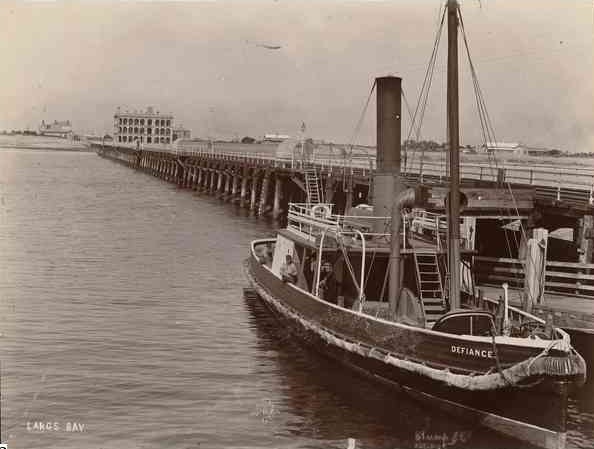 Among the excursions proposed for the Easter holidays is one now being promoted by Captain R. R. Armstrong. Particulars are advertised this morning. The steamer Albatross, with Captain Amora in charge, has been chartered for the purpose, and it is proposed to form a party of from 20 to 80 gentlemen to visit Lord Howe Island, where there is abundance of shooting, fishing, and other sport. The trip will occupy 10 days, and the arrangements will allow a stay of five or six days on the island. NEWS OF THE DAY. (1886, April 16). The Sydney Morning Herald (NSW : 1842 - 1954), p. 7. Retrieved from http://nla.gov.au/nla.news-article13643222
Among the excursions proposed for the Easter holidays is one now being promoted by Captain R. R. Armstrong. Particulars are advertised this morning. The steamer Albatross, with Captain Amora in charge, has been chartered for the purpose, and it is proposed to form a party of from 20 to 80 gentlemen to visit Lord Howe Island, where there is abundance of shooting, fishing, and other sport. The trip will occupy 10 days, and the arrangements will allow a stay of five or six days on the island. NEWS OF THE DAY. (1886, April 16). The Sydney Morning Herald (NSW : 1842 - 1954), p. 7. Retrieved from http://nla.gov.au/nla.news-article13643222
SHIPPING. ARRIVAL. May 18 - ALBATROSS. Government steamer, Captain J H Amora from Broken Bay 15th instant. SHIPPING. (1886, May 19). The Brisbane Courier (Qld. : 1864 - 1933), p. 4. Retrieved from http://nla.gov.au/nla.news-article4495392
Right: SS Defiance: Launched, 1881, a Rock Davis of Blackwall, NSW built ship. Her Gross weight was 64 tons, Dimensions: 82.80 x 16.20 x 6.80 (feet) Defiance was originally one of the fleet of Joubert ferries that ran on the Parramatta River & Hunters Hill routes. Earlier in her career she appears on the Sydney to Gosford route along with Promise, Genista , Gosford and Charlotte Fenwick.
TOWAGE OF LIGHTERS TO AND FROM THE PUBLIC MAGAZINES AT BROKEN BAY AND PORT JACKSON.
NOTICE is hereby given that TENDERS will be received at this Office until Noon of TUESDAY', the 13th instant, from persons willing to supply a steamer (duly certificated by the Marine Board for sea going purposes capable of towing Lighters to and from the Port of Sydney and the Floating Magazine Station at Pittwater, Broken Bay, for a period of three calendar months from date of acceptance of contract, with the right reserved to the Government to renew for a further period of three calendar months, on conditions to be obtained at this office. Each Tender must be accompanied by a marked cheque of £20, and in the case of the accepted tender this amount will be held as a guarantee for the faithful performance of the service. Tenders to be addressed to tho Under-Secretary of Finance and Trade, and endorsed " Tender for Towage of Lighters." P. A. JENNINGS. The Treasury, New South Wales, 8th July. 1886. Advertising. (1886, July 10). The Sydney Morning Herald (NSW : 1842 - 1954), p. 5. Retrieved from http://nla.gov.au/nla.news-article13636181
In 1887 a report was prepared for the N.S.W.'s Government by Major-General Schaw on the Defence of the state and Pittwater was included:
THE DEFENCES OF NEW SOUTH WALES - REPORT BY MAJOR-GENERAL SCHAW.
DEFECTIVE ORGANISATION. ARMING OF SYDNEY AND RE-ORGANISATION OF THE FORCES REQUIRED. .
The report of Major-General Schaw, who was appointed by the Government some months ago to inspect the defences of New South Wales, and to consider what further measures are necessary for security against any probable attacks to which the colony may be liable, was laid on the table of the Legislative Assembly by the Premier yesterday afternoon. Sir Henry Parkes, in presenting the document to Parliament, mentioned that certain passages were omitted...
Broken Bay and Hawkesbury River.
" A hostile fleet, finding the defences at Port Jackson and Botany Bay too strong for them, might be induced to enter Broken Bay with the view of landing troops there. There is ample and safe anchorage for a large number of ships in this harbour, but the distance from Sydney is about 21 miles (or 12 miles from the head of the Pittwater Creek to Manly). This creek, however, is not navigable for large vessels, having a bar at the entrance, and the country between Broken Bay and the Hawkesbury River and Sydney is rocky, precipitous, and covered with scrub and forest, and quite impracticable for the march of troops, except on the two roads leading from the head of Pittwater to Manly Beach, and to the spit ferry over the Middle Harbour, or by the railway from the site of the bridge now under construction at "Dangar Island to Sydney. These lines of approach are so difficult and so easily defended that with the most ordinary precautions any small body of troops attempting to leach Sydney by these routes could be stopped and defeated with" ease. A large expedition would, in course of time, be able perhaps to force its way to Sydney; but the undertaking would be most arduous and prolonged, and its ultimate success would be most doubtful... To construct defences which would prevent an enemy’s warships from entering Broken Bay or landing troops there would be very expensive both in guns, mines, fortifications, and garrisons, for the waters are wide and deep. Such strong defences are, however, at present unnecessary, and all that I could now recommend would be to "construct a battery on Long Island over the tunnel leading to the bridge to the west of Dangar Island, and to station in wartime two gunboats and two torpedo-boats in these waters. The battery might be armed with two or three 80-pounders, as may be found best when the site is surveyed. The navigation here is so difficult that no large ships can manoeuvre freely, and these guns, with the gunboats and torpedo boats, should prevent any minor attack or a landing at the railway station or at Peat's Ferry above it. If a landing were effected at the head of Pittwater an enemy might pursue two routes, one along the beach to Brighton (Avalon), a point which infantry might also reach in fine weather by a landing on the ocean beach there, but which only leads to the Spit Ferry, where he would be stopped, or he might follow the road which leads into the Hornsby-North Willoughby-road, about 4 miles east of the former place. This road is very difficult, and offers numerous points of advantage where such an advance might easily be stopped by a very small force. In view, however, of the disadvantages before alluded to, connected with a landing being permitted, it might be advisable in wartime to extemporise a battery for two position guns and two machine guns at Rockhead, by Coasters' Retreat in Pittwater, to assist the gunboats in preventing any landing party from passing up Pittwater a battery in this retired position would not have to contend with the heavier guns carried by ships. These precautions, aided by a good system of outposts, with a strong reserve near Hornsby, should secure Sydney from any land attack on the north side. Although I have suggested two batteries to assist in the defence of these waters, I do not consider them as of first importance. The difficulties of an advance from Broken Bay on Sydney are so great that no small force would attempt it ; and, as before stated, time must certainly be afforded for preparation in case a larger expedition were meditated, under such circum-stances the roads from Pittwater and from Peat's Ferry, as well as the railway, could be fortified so strongly that the task imposed on an enemy to force his way by these lines would be excessively onerous. The complete defence of this harbour against a strong attack could not be effected by a smaller armament than about the following :-49-in. howitzers, 38-in. B.L. guns, 4 C-in. ditto, 2 6-pr. Q.F., 4 rifle-calibre guns." These with submarine mines and Works would cost about £100,000, and would require a garrison of about 150 artillerymen and ... with naval accessories to man guard-boats. Such expenditure is clearly not needed at present....THE DEFENCES OF NEW SOUTH WALES. (1887, December 2). The Sydney Morning Herald (NSW : 1842 - 1954), p. 11. Retrieved from http://nla.gov.au/nla.news-article13676270
The perceived threat, despite German battleships visiting Victoria during this same period and beginning to carry mail, saw a Royal Navy force requested from Britian and a new ship arrive in Sydney soon after as answer:
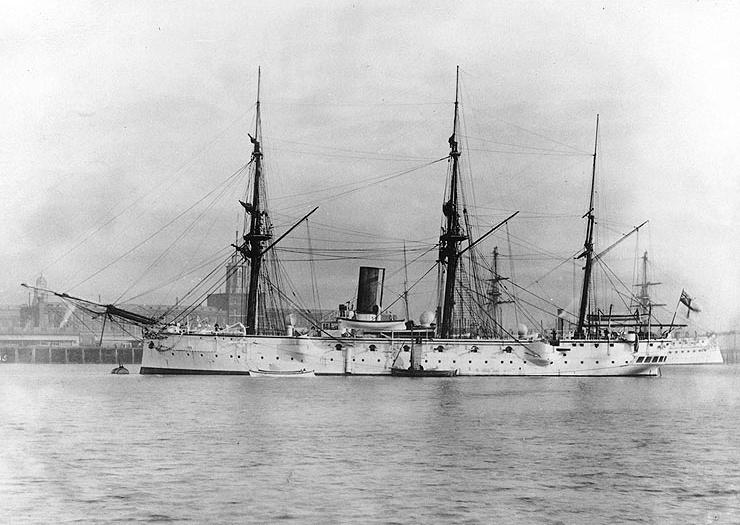 H.M.S. Calliope, which has been expected for several days past, moored to the Nelson's buoy in Farm Cove yesterday forenoon. She has come direct from Hong-kong under steam alone, a distance of about 6000 miles, which is a good indication of what she can do in the shape of cruising. She is quite a new ship, now on her first commission, has the latest description of ordnance, and is the most powerful offensive vessel in these waters. She left England in February last to join the China squadron, but on September 13 a cable message was received from the Admiralty ordering her to proceed to Sydney forthwith. A full description of the Calliope appears in another column. NEWS OF THE DAY. (1887, November 16). The Sydney Morning Herald (NSW : 1842 - 1954), p. 9. Retrieved from http://nla.gov.au/nla.news-article13677518
H.M.S. Calliope, which has been expected for several days past, moored to the Nelson's buoy in Farm Cove yesterday forenoon. She has come direct from Hong-kong under steam alone, a distance of about 6000 miles, which is a good indication of what she can do in the shape of cruising. She is quite a new ship, now on her first commission, has the latest description of ordnance, and is the most powerful offensive vessel in these waters. She left England in February last to join the China squadron, but on September 13 a cable message was received from the Admiralty ordering her to proceed to Sydney forthwith. A full description of the Calliope appears in another column. NEWS OF THE DAY. (1887, November 16). The Sydney Morning Herald (NSW : 1842 - 1954), p. 9. Retrieved from http://nla.gov.au/nla.news-article13677518
Despite the Government of the day refusing to divulge where the defence of the colony, her armaments and powder hulks were, everyone seemed to know where the powder hulk at Pittwater was;
On the Towler's Bay side there are several residents who pull across the water to the wharf at Church Point and meet the steamer from Sydney or the coach from Manly, as the case may be. The dynamite powder hulk is moored in Towler's Bay, with residences on shore for the officers in charge.
Mr. Robert Robinson has his residence of Raamah at the same place. Mr. Robinson informs me that he can grow to perfection such tropical fruits as bananas, guavas, ginger, mangoes, pineapples, Brazilian cherries, &c. This fact will demonstrate that there can belittle or no frost in this locality. Other residents of this side of the bay are Mr. F. Chave, Wood-lands, who has a very nice orchard, mostly summer fruit ; Mr. E. C. Johnstone, who has a nice residence and orchard; Mr. A. Steffani is another prominent resident, while the residence of the firm of Flood and Oately occupies a lovely peninsula in the quiet waters of the bay. Mr. Geo. Brown has a residence and an orchard in the neighborhood, and there is also a small church and cemetery at Church Point. Manly to Broken Bay. (1893, November 11). Australian Town and Country Journal (NSW : 1870 - 1907), p. 19. Retrieved from http://nla.gov.au/nla.news-article71191632
With a growing number of people in Pittwater, who shipped a lot of food into Sydney, as well as a focus to attract visitors, excursionists and holiday makers to the area, the powder hulk, and the distance between it and Sydney, began to shift a consensus to get rid of the Prospector:
Those merchants who deal in dynamite consider that they have just cause of complaint against the existing arrangements for the safe storage of that article at present dynamite is stored in hulk under the Government’s supervision in Broken Bay. Those desirous of replenishing their private magazines can only do so on two days of the week-on Tuesdays and Thursdays. Occasionally it so happens that owing to the heavy seas running along the coast it is found impossible to got supplies on those days, and vexatious delays result. As a case in point, it may be stated that dynamite was ordered for a certain Thursday about a fortnight or three weeks ago. Owing to the rough weather the order was not attended to, but it was promised without fail on the following Tuesday, which also turned out to be a boisterous day, so that it was only on the next Tuesday that the supplies arrived, leaving about 12 day s consecutive without there being any possibility of fulfilling customers' orders. Last Thursday was another of the frequent rough days, and supplies have been promised on Tuesday , but as the vessel has to go down on the day before, and as Monday is a holiday, merchants do not expect the fulfilment of the promise. Licensed private magazines are only allowed to carry small quantities under heavy penalties, so that these delays are often serious to mine-owners and those engaged in excavating operations, who naturally blame merchants for the delay. It has been suggested that the dynamite should be stored in Middle Harbour with the powder, or as there seems to be an objection to the two articles being stored together on the same hulk, another could be obtained and the delay thus obviatal. The storage of 3d per week per 30lb case is also deemed excessive. IMPORT MARKET. (1895, October 5). The Sydney Morning Herald (NSW : 1842 - 1954), p. 11. Retrieved from http://nla.gov.au/nla.news-article14019636
Sir Griffiths said that a deputation had waited upon the Minister for Justice, in the absence of the Premier, and had asked that the dynamite hulk in Broken Bay should be removed to a site nearer to the Hawkesbury, but still to be kept in the bay. The reply which had subsequently been received from the department was that it was not desirable to remove the hulk from the bay. This was not considered to be an answer to the request of the deputation. THE DISTRIBUTION OF EXPLOSIVES. (1896, July 30). The Sydney Morning Herald (NSW : 1842 - 1954), p. 7. Retrieved from http://nla.gov.au/nla.news-article14060576
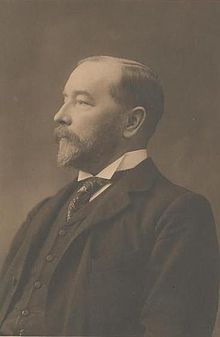 STORAGE OF EXPLOSIVES.—Mr. Dugald Thomson, M.L.A., introduced a deputation to the Premier yesterday, which asked for an amendment of the regulations relating to the storage of explosives. It was pointed out by Mr. Griffith (Dalgety and Co.) with regard to "high explosives," dynamite cartridges used in mining, &c., that the hulk in which these articles were stored was in Broken Bay, near Newport, which meant a long journey by sea. It was proposed that the hulk should be moved to Middle Harbour. Mr. Lyne at once said that he saw no objection to this being done, and the members of the deputation expressed themselves as being satisfied with the arrangement. It was further pointed out to the Premier that in Melbourne the charge for the storage of dynamite was one penny per case per week, whilst in Sydney, it was 3d per case per week. In South Australia and Queensland the charge was 1½d per case. Mr. Lyne said that the receipts of this department last year did not equal the expenditure by £1185. He promised, however, that he would look into the matter, with the view of seeing if any reduction in the charge could be made. The Sydney Morning Herald. (1900, January 19). The Sydney Morning Herald (NSW : 1842 - 1954), p. 6. Retrieved from http://nla.gov.au/nla.news-article14233506
STORAGE OF EXPLOSIVES.—Mr. Dugald Thomson, M.L.A., introduced a deputation to the Premier yesterday, which asked for an amendment of the regulations relating to the storage of explosives. It was pointed out by Mr. Griffith (Dalgety and Co.) with regard to "high explosives," dynamite cartridges used in mining, &c., that the hulk in which these articles were stored was in Broken Bay, near Newport, which meant a long journey by sea. It was proposed that the hulk should be moved to Middle Harbour. Mr. Lyne at once said that he saw no objection to this being done, and the members of the deputation expressed themselves as being satisfied with the arrangement. It was further pointed out to the Premier that in Melbourne the charge for the storage of dynamite was one penny per case per week, whilst in Sydney, it was 3d per case per week. In South Australia and Queensland the charge was 1½d per case. Mr. Lyne said that the receipts of this department last year did not equal the expenditure by £1185. He promised, however, that he would look into the matter, with the view of seeing if any reduction in the charge could be made. The Sydney Morning Herald. (1900, January 19). The Sydney Morning Herald (NSW : 1842 - 1954), p. 6. Retrieved from http://nla.gov.au/nla.news-article14233506
The Hon. Dugald Thomson won the New South Wales Legislative Assembly seat of Warringah in 1894. homson was a supporter of federation and won the House of Representatives seat of North Sydney at the 1901 election and held it to his retirement prior to the 1910 election. He was always a firm supporter of people in Pittwater and fought to build wharves on the estuary, much needed in a maritime focused almost roadless community, and was well known for addressing any issue on Maritime needs in parliament.
With the shifting of the Powder hulk from Pittwater to Middle Harbour (now called 'Powder Hulk Bay') the few acres of Ordnance Reserve at Towlers was sold to the newly formed Kuringgai Trust.
References:
1. COLONIAL DEFENCE 1855 - 1900. Retrieved from http://freepages.history.rootsweb.ancestry.com/~ausnavy/colonial_navy_defence.htm
Naval Historical Society of Australia: http://www.navyhistory.org.au/
The Naval Officers Club of Australia: http://www.navalofficer.com.au/home-2/
George Champion OAM and Shelagh Champion OAM. A Night on the Powderhulks. May 2003.
Dean Boyce, 'Defending colonial Sydney', Dictionary of Sydney, 2008, From HERE
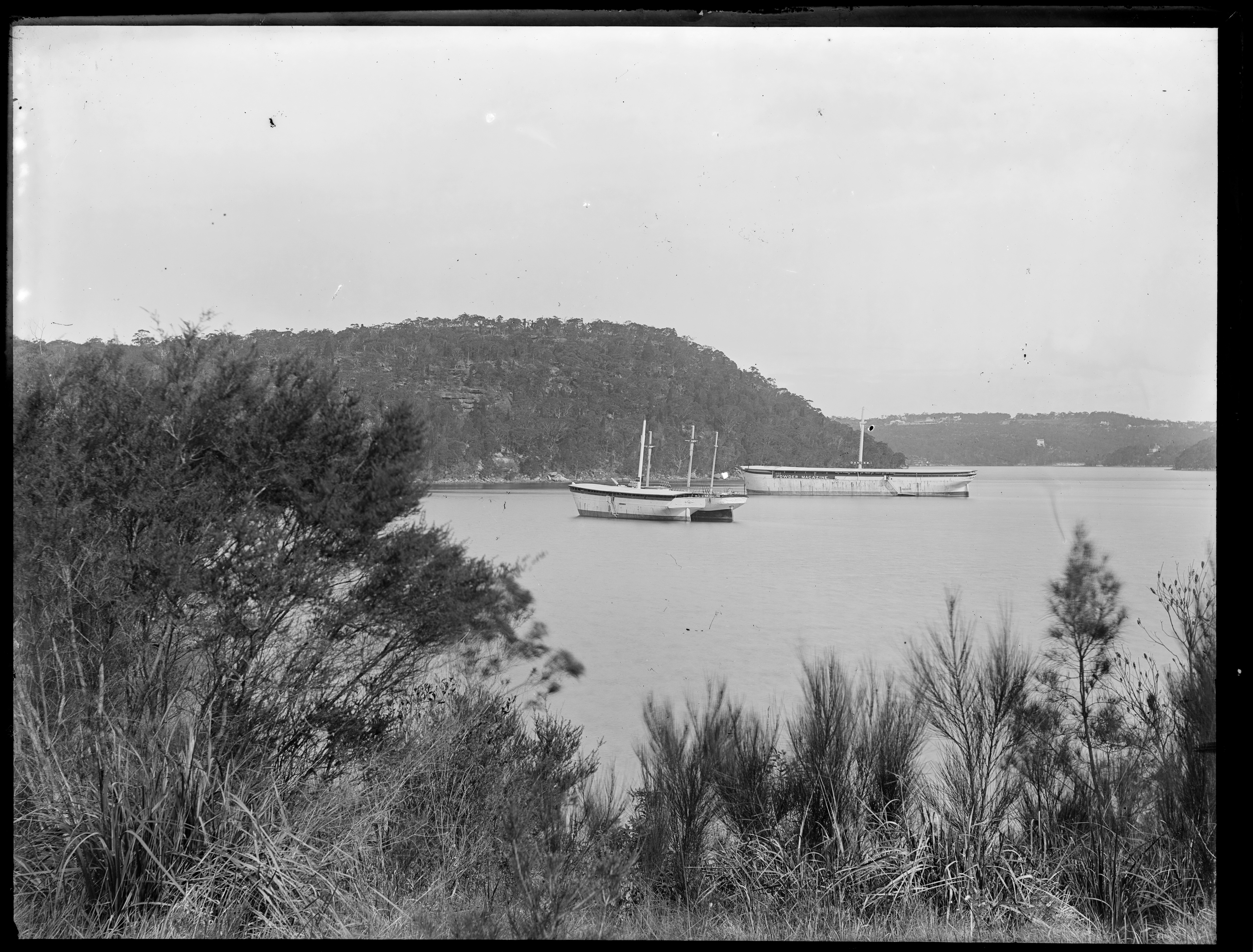
The Powder Hulks, Middle Harbour.
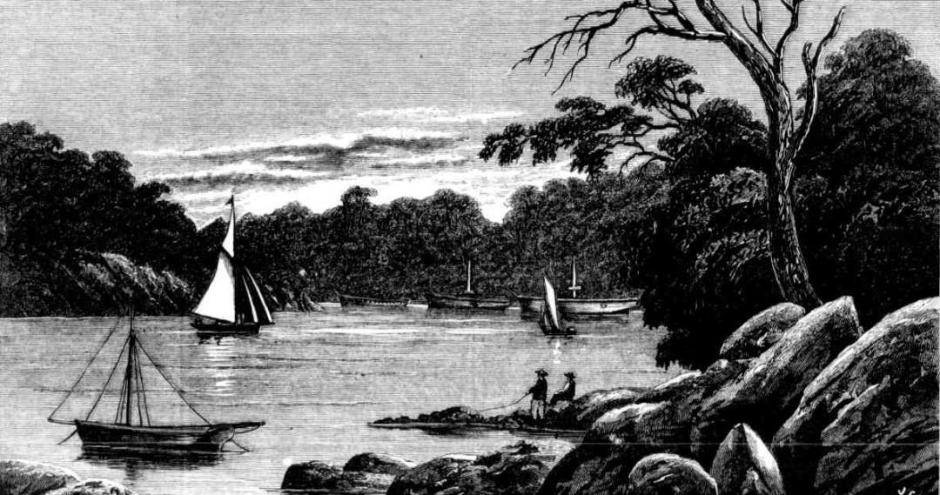
Above: Some months ago the city was scared by the statement that powder enough was stowed in the magazines at Goat and Spectacle islands to reduce all our houses to ruins, and dynamite enough to make powder of the ruins. Ministers were importuned about the business, but they said it had always been so and it always would be so, or, at least they implied so much by their studied inaction. We' hurt
grown almost accustomed to the consciousness as well as the presence, of danger before it was' decided that some of the powder should be shifted. Many localities were spoken of, and at last one was chosen far up Middle Harbour, quite away from town -away also from the ordinary tracks of tourists. Yachts beat up sometimes and cruise about the old hulks, and with good wind venture even a little farther up the narrowing estuary ; but other life there is none. A little farther up that ' Artisans' College ' which is now amusing the Court and filling the daily pipers might be found; a little lower, some of the loveliest homes our harbour foreshore knows ; but immediately around the hulks nothing hut rocks and water and trees. An explosion could only wreck beauty, and beauty would rise again, we know. The powder is safer down there and the old hulks complete rather than mar the picture. | POWDER HULKS, MIDDLE HARBOUR. The Powder Hulks, Middle Harbour. (1883, June 16). The Sydney Mail and New South Wales Advertiser (NSW : 1871 - 1912), p. 1120. Retrieved fromhttp://nla.gov.au/nla.news-article162079372

Millers Point, Sydney: ca. 1875-1885; Kent Street (foreground) including Captain Cook Hotel & Thomas Huntley butcher (corner of Miller's Road) ; Looking toward Simmons Point, Ballast Point & Long Nose Point (from left) ; Goat Island (right). Image No.: a089921, courtesy State Library of NSW.